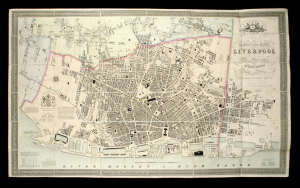Cornucopia of historical treasures: maps, talks, Ged Fagan and Peter Ellis
Liverpool Landscapes was a blog charting new discoveries, news and developments affecting Liverpool's historic environment. It was regularly updated between 2007 and 2016.
Liverpool Landscape has now been retired, and most of the less time-dependent articles moved to Historic Liverpool.

Happy New Year!
Well, by the time you read this we’ll be well into 2015, but it seems the right thing to say, as I’m planning to reinvigorate Liverpool Landscapes, which has gone a bit quiet over the last couple of years. My excuse is that I’ve become self-employed, and only just getting to grips with managing my time!
I also received a message from WordPress telling me all about my year in blogging. Compared to previous years, there were far fewer readers here (9,600 page views compared to 19,000 in 2012), and so I feel it’s time to work a little harder. There are so many great Liverpool blogs out there that are inspiring – I hope I can get just a little of what they’re doing!
And so, here are a handful of news stories which might have piqued your curiosity over the last few weeks. Let me know if this is the kind of thing you want. If it is, tell your friends too!
- Scottie Press team up with Ged Fagan. The Scottie Press is a decades-old community newspaper serving Vauxhall Road and Scotland Road. It includes a whole host of news and events about the area, but for our interests I wanted to point out that Ged Fagan, active member of several history forums (including SP’s own) and creator of the amazing and colossal ‘In A City Living’ website and book has written a column about himself. He talks about his life growing up, and how he came to amass his archive of photos, many of Liverpool landscapes long gone. It’s already an important collection, and will only grow in importance over the decades. He’s also the creator of the model of Gerard Gardens which is on display in the Liverpool Museum. There’s a suggestion that this is a regular column, but no mention as to whether this is the first one. Read Ged’s article on the Scottie Press website.
- Peter Ellis book addition. If you’re interested in Liverpool history then you’ll probably have already heard of Peter Ellis. You may even know that a book came out last year celebrating his work (In the Footsteps of Peter Ellis available from the Liverpool History Society shop, Amazon [currently out of stock] and elsewhere). Now the Society have added an electronic volume called The Signatures of Peter Ellis, of especial interest to those who already have the first book, but also of wider appeal. It contains a lot of the extra research carried out for Footsteps, but which didn’t fit into the original volume. You can download The Signatures of Peter Ellis as a PDF from the Liverpool History Society website.
- Steve Binns on Facebook. Like most of those who’ve got really deeply into Liverpool history, I’ve known about Steve Binns for years, mainly through his appearances on television, but also through his work for the Liverpool Echo and Radio Merseyside. He also gives tours of his beloved city, and regular talks at St. George’s Hall. However, I’ve been a bit slow to find Steve’s Facbook page. Only the worthy can really justify having a personal Facebook ‘Public Figure’ page, and Steve’s is worthwhile following. You can keep up to date with his talks, as well as watching clips from his recent talks. You can see Steve Binns’s page on Facebook, and see some of his Liverpool Old Dock talk on YouTube.
- The Futurist’s façade may survive. The Futurist was a cinema on Lime Street, which has seen many threats to its structure over the last few years. A campaign to Save the Futurist was launched, in a bid to stop the developers of the site, Neptune, from demolishing it wholesale as they build student flats and a hotel. Trouble began to brew when images came out of the developer showing no sign of the façade surviving the building process. However, Liverpool City Council have jumped to reassure us all that these images are ‘speculative’, and that a ‘section’ of the Futurist will be preserved. What exactly this means remains to be seen, but you can read about plans for the Futurist on the Liverpool Echo website.
- Gage’s Map of Liverpool, 1836. Finally, for this week, I’ve stumbled across this digital version of Michael Alexander Gage’s amazing map of Liverpool, or more properly “This trigonometrical plan of the town and port of Liverpool [cartographic material] : including the environs of Edge Hill & Toxteth Park, Kirkdale, Everton, Low Hill from actual survey“. Drawn in 1836, it’s been put online by the National Library of Australia, and you can pan around, zoom in and out, and see more details about the map, from an archival point of view. You can zoom in to an amazing level of detail, and remind yourself just how much is shown on this map. For example, I love exploring the area around St. James’s Mount (later the Anglican Cathedral). At the time of the plan, this was the salubrious outer suburbs of the burgeoning town, and each individual house is drawn. Explore Gage’s plan of Liverpool on the NLA’s website.
That’s all for now, folks. Tune in next time when we’ll have a look at more news affecting Liverpool’s historic landscape.



